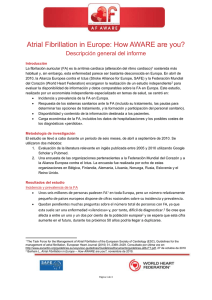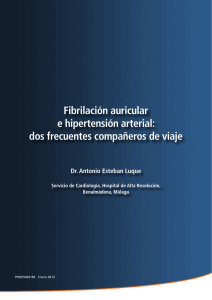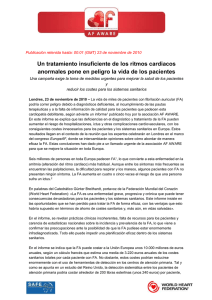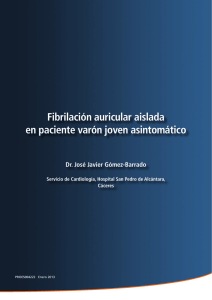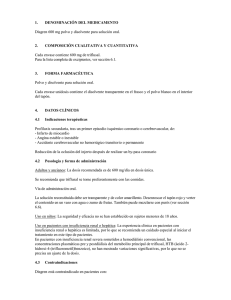1.- PPT: NOVEDADES EN ANTIAGREGACIÓN/ANTICOAGULACIÓN 2008
Anuncio
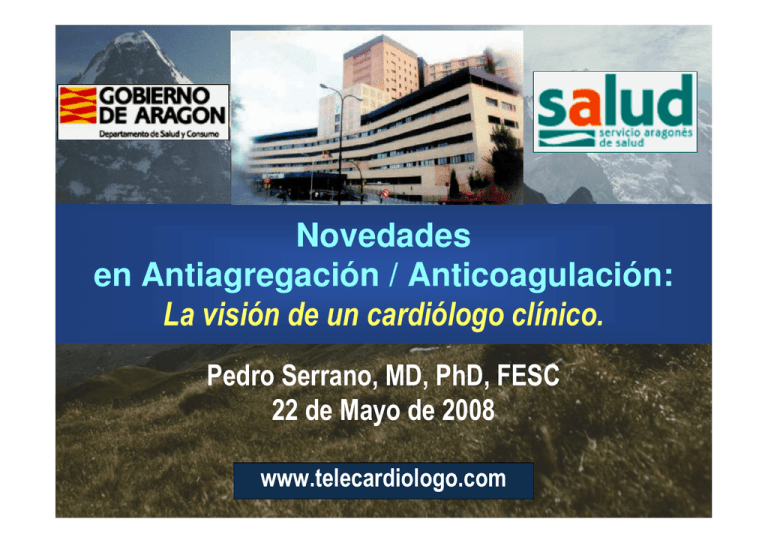
Novedades en Antiagregación / Anticoagulación: La visión de un cardiólogo clínico. Pedro Serrano, MD, PhD, FESC 22 de Mayo de 2008 www.telecardiologo.com Agradecimientos: a Laboratorios Uriach a la Dra. Rosa Cornudella a todos vosotros. Introducción y justificación ¿Por qué?: 1.- En España unas 1.000.000 personas toman aspirina a dosis bajas. 2.- En España unas 600.000 personas toman anticoagulantes. 3.- Ambos tratamientos, así como el uso de terapias combinadas (varios antiagregantes, o antiagregante + anticoagulante), están aumentando. 4.- El control “diario” de estos pacientes recae en el Médico de Atención Primaria. 5.- Son tratamientos crónicos. La Aterotrombosis es la Principal Causa de Muerte en el Mundo 6.3 Enfermedad Pulmonar Accidentes 9 SIDA 9.7 Cáncer 12.6 Enfermedades Infecciosas 19.3 22.3 Aterotrombosis* 0 5 10 15 20 25 30 Causas de Mortalidad (%) * La Aterotrombosis definida como enfermedad isquémica del corazón y enfermedad cerebrovascular. 1 The World Health Report 2001. Geneva. WHO. 2001. Prevalencia de Ictus en Adultos según Edad y Sexo Edad (años) Ambos Sexos % (ES) Hombres % (ES) Mujeres % (ES) 20-29 0.2 (0.00) 0.3 (0.00) 0 (0.00) 30-39 0 (0.00) 0 (0.00) 0 (0.00) 40-49 1.3 (0.01) 0.9 (0.01) 1.8 (0.01) 50-59 3.0 (0.01) 3.2 (0.01) 2.8 (0.01) 60-69 6.1 (0.01) 6.1 (0.01) 6.0 (0.01) ≥70 6.4 (0.01) 9.1 (0.02) 4.6 (0.01) TODAS 1.4 (0.00) 1.3 (0.00) 1.5 (0.00) Antonio L. Dans, M.D., Dante D. Morales, M.D., Felicidad Velandria, Teresa B. Abola, M.D., Artemio Roxas Jr., M.D., Felix Eduardo R. Punzalan, M.D., Rosa Allyn G. Sy, M.D., Elizabeth Paz Pacheco :National Nutrition and Health Survey (NNHeS): Atherosclerosis - Related Diseases and Risk Factors: Phil. J of Intern Med May-June 2005,Vol.43.Impress Prevalencia de Diagnóstico Previo de Ictus por Edad 7 6.4% 6 6.1% 5 4 3 3.0% 2 1 1.3% 0 20-29 30-39 40-49 50-59 60-69 >70 Antonio L. Dans, M.D., Dante D. Morales, M.D., Felicidad Velandria, Teresa B. Abola, M.D., Artemio Roxas Jr., M.D., Felix Eduardo R. Punzalan, M.D., Rosa Allyn G. Sy, M.D., Elizabeth Paz Pacheco :National Nutrition and Health Survey (NNHeS): Atherosclerosis - Related Diseases and Risk Factors: Phil. J of Intern Med May-June 2005,Vol.43.Impress Distribución de Ictus por Subtipos 5% 10% 85% Infarto HIC HS Infarto HIC: Hemorragia Intracerebral HS: Hemorragia Subaracnoidea Albers GW, et al. Antitrombotic and thrombolytic therapy for ischemic stroke. Chest 2001; 119;300S-320S Epidemiología de las Manifestaciones Aterotrombóticas en USA Incidencia Prevalencia Infarto Miocardio 0.65 millones*1 7.5 millones1 Ictus 0.5 millones*1 4.6 millones1 Enfermedad Arterial Periférica Variable dependiente de la población 2 10.5 millones†3 * Sólo primer episodio †· Pacientes con EAP en Norteamérica (USA y Canada): sintomáticos (37.5%) y asintomáticos (62.5%) 1. 2. 3. American Heart Association. 2002 Heart and Stroke Facts: Statistical Update. Ouriel K et al. Lancet 2001; 358: 1257–64. Weitz JI et al. Circulation 1996; 94: 3026–49. Solapamiento de la Enfermedad Vascular en Pacientes con Aterotrombosis Estudio CAPRIE Enfermedad Cerebral Enfermedad Coronaria 25% 7% 30% 3% 4% 12% 19% Enfermedad Arterial Periférica Gent et al. for the CAPRIE Study Organisation. Lancet 1996; 348: 1329-1339. Antithrombotic Trialists’ Collaboration: Eficacia del Tratamiento Antiagregante en los Eventos Vasculares* Categoría % reducción riesgo Infarto agudo miocardio Ictus agudo Infarto miocardio previo Ictus o Ataque Isquémico Transitorio previos Otros grupos alto riesgo • Enfermedad arterial coronaria (ej. angina inestable, insuficiencia cardíaca) • Enfermedad arterial periférica • • (ej. claudicación intermitente) Alto riesgo de embolismo (ej. fibrilación auricular) “Otras” (ej. diabetes mellitus) Todos Estudios 22% 0.0 0.5 1.0 Antiagregante mejor 1.5 Control mejor *Eventos vasculares = infarto miocardio, ictus o muerte vascular Antithrombotic Trialists’ Collaboration. BMJ 2002; 324: 71–86. 2.0 Antithrombotic Trialists’ Collaboration: La Evidencia Indica Bajas Dosis de AAS (75–150mg) Dosis AAS % reducción riesgo 500–1500 mg/día 160–325 mg/día 75–150 mg/día < 75 mg/día 23% Cualquier dosis AAS (p < 0.0001) 0.0 AAS mejor 0.5 1.0 1.5 2.0 Control mejor Antithrombotic Trialists’ Collaboration. BMJ 2002; 324: 71–86. Antithrombotic Trialists’ Collaboration: Conclusiones (I) • El tratamiento antiagregante debe ser considerado rutinario para todos los pacientes de riesgo • El tratamiento antiagregante reduce los eventos vasculares graves en un amplio rango de pacientes de alto riesgo: – Infarto agudo de miocardio (IAM) e ictus agudo – IAM previo e ictus/ataque isquémico transitorio previos – Enfermedad arterial coronaria (ej. angina inestable, insuficiencia cardiaca) – Enfermedad arterial periférica (ej. claudicación intermitente) – Alto riesgo de embolismo (ej. fibrilación auricular) – Otros factores de alto riesgo (ej. diabetes)1 • El tratamiento antiagregante debe continuar a largo plazo2,3 1. Antithrombotic Trialists’ Collaboration. BMJ 2002; 324: 71–86. 2. Braunwald E et al. JACC 2000; 36: 970–1062. 3. Bertrand ME et al. Eur Heart J 2000; 21: 1406–32. Antithrombotic Trialists’ Collaboration: Conclusiones (II) • Bajas dosis de AAS (75–150 mg/día) son tan efectivas como dosis altas de AAS en el tratamiento a largo plazo1 • Los antagonistas de receptores de ADP son los únicos agentes antiagregantes que han demostrado superioridad respecto al AAS en la reducción de riesgo1,2 • Añadir un segundo fármaco antiagregante (ej. clopidogrel o antagonista GPIIb/IIa) al AAS puede producir beneficios adicionales1 1. Antithrombotic Trialists’ Collaboration. BMJ 2002; 324: 71–86. 2. Antiplatelet Trialists’ Collaboration. BMJ 1994; 308: 81–106. 3. The CURE Trial Investigators. N Engl J Med 2001; 345: 494–502. Desarrollo 1.- Fibrilación auricular Alta prevalencia. La gran mayoría se anticoagulan. Ver papel Información pacientes 2.- Estudios NASPEAF 2004 (estudio inicial), 2006 (subanálisis estenosis mitral), 2007 (subanálisis ancianos). NASPEAF NAtional Study for Prevention of Embolism in Atrial Fibrillation Efectos comparativos de antiagregante, anticoagulante o tratamiento combinado en pacientes con fibrilación auricular valvular y no valvular. Un estudio randomizado multicéntrico (NASPEAF) Pérez Gomez, et al. J Am Coll Cardiol 2004; 44: 1557-66 NASPEAF NAtional Study for Prevention of Embolism in Atrial Fibrillation Objetivo: Evaluar la eficacia y seguridad de la combinación de un antiagregante (Triflusal) + anticoagulación de intensidad moderada en pacientes con ACXFA y factores de riesgo vascular o estenosis mitral. Métodos: Prospectivo, multicéntrico, randomizado, “open label” con comités de seguridad y eventos “ciegos”. Pérez Gomez, et al. J Am Coll Cardiol 2004; 44: 1557-66 NASPEAF NAtional Study for Prevention of Embolism in Atrial Fibrillation End point primario: Incidencia combinada de muerte vascular, AIT, ictus no fatal o embolismo sistémico. End points secundarios: Muerte vascular AIT. Ictus no fatal. Embolismo sistémico no fatal. IAM no fatal. Muerte no vascular. Sangrado severo (ingreso hospitalario y/o transfusión de sangre). Combinación de algunos de ellos. Pérez Gomez, et al. J Am Coll Cardiol 2004; 44: 1557-66 NASPEAF NAtional Study for Prevention of Embolism in Atrial Fibrillation Riesgo intermedio: Fibrilación auricular + 1 de: • > 60 años • HTA • Insuficiencia Cardiaca • Diabetes Incluidos N= 1209 Alto riesgo: Fibrilación auricular + 1 de: • Embolismo previo. • Estenosis mitral. • Embolismo previo + EM . Alto riesgo N= 495 Riesgo intermedio N= 714 Triflusal 600mg/día N= 242 N= 7 INR medio: 2,47 INR medio: 1,93 INR 2-3 N= 237 Trifl+INR=1,25-2 N= 235 N= 5 N= 13 INR medio: 2,50 INR 2-3 N=259 N= 12 INR medio: 2,17 Trifl.+INR=1.4-2.4 N= 236 N= 13 N= 235 N= 232 N= 222 N= 247 976 944 976 106 4 Pérez Gomez, et al. J Am Coll Cardiol 2004; 44: 1557-66 Perdidos en el seguimiento N= 223 ITT 108 5 Seguimiento medio (días) NASPEAF NAtional Study for Prevention of Embolism in Atrial Fibrillation Características basales - I RIESGO INTERMEDIO ALTO RIESGO TRIFLUS N= 242 ANTICOA N= 237 ANTICOA COMBINED N= 259 N= 236 Edad media (años) 69.9 69.6 69.8 66.6 67.3 Varones 57.0 54.6 57.4 31.3 28.7 Fumadores 37.4 39.0 40.2 28.3 22.4 Diabéticos 17.1 17.0 14.6 14.3 16.7 Dislipemia 31.0 30.0 27.4 30.4 32.4 HTA 42.7 45.0 45.2 33.2 30.0 Cp. isquémica 18.4 16.5 13.5 7.8 9.5 3.8 1.7 2.7 3.3 1.8 Enf. vascular periférica COMBINED N= 235 Pérez Gomez, et al. J Am Coll Cardiol 2004; 44: 1557-66 NASPEAF NAtional Study for Prevention of Embolism in Atrial Fibrillation Características basales - II RIESGO INTERMEDIO TRIFLUSAL N= 242 ANTICOA N= 237 COMBINED N= 235 ALTO RIESGO ANTICOA N= 259 COMBINED N= 236 Insuficiencia cardiaca 11.2 22.7* 10.5 20.6 14.1 NYHA clase II-IV 59.0 50.0 44.0 44.0 45.0 FEVI 61.0 60.0 60.2 63.7 62.1 Diámetro auricular izdo (mm) 46.2 47.4 47.0 52.6 51.7 FA no valvular + embolismo (n) --- --- --- 95 89 Estenosis mitral + embolismo --- --- --- 50 45 Estenosis mitral no embolismo --- --- --- 114 102 Pérez Gomez, et al. J Am Coll Cardiol 2004; 44: 1557-66* P< 0.001 vs TRI and COMB NASPEAF NAtional Study for Prevention of Embolism in Atrial Fibrillation Valores de anticoagulación RIESGO INTERMEDIO ALTO RIESGO ANTICOA N= 237 COMBINED N= 235 ANTICOA N= 259 COMBINED 2.00 - 3.00 1.25 - 2.00 2.00 - 3.00 1.40 - 2.40 2.47 1.93* 2.50 2.17* 2.33 - 2.60 2.83 - 2.09 2.37 - 2.65 1.97 - 2.36 Tiempo en el rango (%) 65.0 66.0 67.0 73.0 Tiempo sobre el rango (%) 16.0 31.0 15.0 23.0 Tiempo bajo el rango (%) 19.0 3.0 18.0 4.0 Nº de INRs < 2 (%) 21.0 67.0* 18.0 39.0* Nº de INRs > 3.5 (%) 6.3 1.96* 7.9 2.40* INR rango objetivo INR (mediana) INR (IQR: P25-P75) N= 236 Pérez Gomez, et al. J Am Coll Cardiol 2004; 44: 1557-66* P< 0.001 vs ANTICOA NASPEAF NAtional Study for Prevention of Embolism in Atrial Fibrillation Grupo de riesgo intermedio End point primario: muerte vascular, ictus no fatal, AIT, embolismo. P= 0.32 % pacientes / año 5.0 4.5 4.0 3.5 3.0 2.5 2.0 1.5 1.0 0.5 0 Triflusal 67% RRR p= 0.02 3.8 2.7 0.9 Anticoagulante Combinado Pérez Gomez, et al. J Am Coll Cardiol 2004; 44: 1557-66 NASPEAF NAtional Study for Prevention of Embolism in Atrial Fibrillation Grupo de riesgo intermedio End point primario: muerte vascular, ictus no fatal, AIT, embolismo. % libre de eventos 100 Combinado 95 Anticoagulante 90 Triflusal Log-rank test, p= 0,004 85 80 0 1 2 Pérez Gomez, et al. J Am Coll Cardiol 2004; 44: 1557-66 3 años NASPEAF NAtional Study for Prevention of Embolism in Atrial Fibrillation Grupo de riesgo intermedio: Resultados de eficacia I TRIFLUSAL pt/y= 576.2 n % pt/y ANTICOA pt/y= 556.1 n % pt/y Primary outcome (ITT) 22 (3.82) 15 (2.70) 5 (0.92)* Primary outcome (OT) 17 (2.95) 14 (2.34) 3 (0.55)** 8 (1.39) 11 (1.98) 2 (0.37)† 10 (1.74) 3 (0.54) 3 (0.55) AIT 3 (0.52) 0 Embolismo sistémico no fatal 1 (0.17) 1 IAM no fatal 1 (0.17) 0 Muerte vascular ACV no fatal COMBINED pt/y= 540.8 n % pt/y 0 (0.18) 0 0 † P= 0.01 vs ANTICOA * P< 0.05 vs ANTICOA and TRI ** P< 0.01 vs ANTIACOA and TRI Pérez Gomez, et al. J Am Coll Cardiol 2004; 44: 1557-66 NASPEAF NAtional Study for Prevention of Embolism in Atrial Fibrillation Grupo de riesgo intermedio: Resultados de eficacia II TRIFLUSAL pt/y= 576.2 n % pt/y Embolismo no fatal-ACV-AIT Embolismo fatal-ACV-AIT Embolismo-ACV-IAM-muerte vascular Muerte no vascular Outcome +sangrado severo ANTICOA pt/y= 556.1 n % pt/y COMBINADO pt/y= 540.8 n % pt/y 15 (2.60) 7 (1.26) 3 (0.55) 1 (0.17) 3 (0.54) 0 16 (2.78) 8 (1.44) 4 (0.74) 7 (1.21) 9 (1.62) 4 (0.74) 22 (3.82) 21 (3.78) 8 (1,48)* * P< 0.05 vs ANTICOA and TRI Pérez Gomez, et al. J Am Coll Cardiol 2004; 44: 1557-66 NAtional Study for Prevention of Embolism in Atrial Fibrillation NASPEAF Grupo de alto riesgo End point primario: muerte vascular, ictus no fatal, AIT, embolismo. 49% RRR 5.0 4.5 4.0 3.5 3.0 2.5 2.0 1.5 1.0 0.5 0 4.76 100 2.44 % libre de eventos % pacientes / año P= 0.03 95 90 Log-rank test, p= 0.03 85 80 0 Anticoagulante 1 Combinado Pérez Gomez, et al. J Am Coll Cardiol 2004; 44: 1557-66 2 3 años NASPEAF NAtional Study for Prevention of Embolism in Atrial Fibrillation Grupo de alto riesgo: Resultados de eficacia I ANTICOA pt/y= 609.7 n % pt/y COMBINED pt/y= 573.1 n % pt/y Primary outcome (ITT) 29 (4.76) 14 (2.44)* Primary outcome (OT) 26 (4.38) 6 (1.10)† Vascular death 17 (2.79) 6 (1.05)* Non-fatal stroke 6 (0.98) 6 (1.05) Transient ischaemic attack (TIA) 3 (0.49) 2 (0.35) Non-fatal sist. embolism 3 (0.49) 0 Non-fatal AMI 2 (0.33) 0 * P< 0.05 vs ANTICOA † P= 0.001 vs ANTICOA Pérez Gomez, et al. J Am Coll Cardiol 2004; 44: 1557-66 NASPEAF NAtional Study for Prevention of Embolism in Atrial Fibrillation Grupo de alto riesgo: Resultados de eficacia II Embolismo no fatal-ACV-AIT Embolismo fatal-ACV-AIT Embolismo-ACV-IAM-muerte vascular Muerte no vascular Outcome +sangrado severo ANTICOA pt/y= 609.7 n % pt/y COMBINADO pt/y= 573.1 n % pt/y 20 (3.28) 12 (2.09) 8 (1.31) 4 (0.70) 25 (4.10) 13 (2.27) 6 (0.98) 6 (1.05) 34 (5.58) 22 (3.84) Pérez Gomez, et al. J Am Coll Cardiol 2004; 44: 1557-66 NASPEAF NAtional Study for Prevention of Embolism in Atrial Fibrillation Sangrado severo % patients / year 2.5 2 p= 0.27 p= 0.02 p= 0.29 1.8 2.1 2.1 1.5 0.9 1 0.5 0.4 0 Riesgo intermedio Triflusal Alto riesgo Anticoagulante Combinado Pérez Gomez, et al. J Am Coll Cardiol 2004; 44: 1557-66 NAtional Study for Prevention of Embolism in Atrial Fibrillation NASPEAF Datos de anticoagulación Riesgo intermedio Riesgo alto Anticoa gulante Tto Combinado 2,47 1,93 2,50 2,17 % tiempo en rango 65 66 67 73 % tiempo sobre rango 16 31 15 23 % tiempo bajo rango 29 3 18 4 INR medio Anticoa Tto gulante Combinado Pérez Gomez, et al. J Am Coll Cardiol 2004; 44: 1557-66 NASPEAF NAtional Study for Prevention of Embolism in Atrial Fibrillation Conclusión: La combinación de un antiagregante (triflusal) y tratamiento anticoagulante de moderada intensidad disminuyó significativamente los eventos vasculares comparados con la anticoagulación sola, y probó ser seguro en los pacientes con fibrilación auricular. Pérez Gomez, et al. J Am Coll Cardiol 2004; 44: 1557-66 NASPEAF: álisis en NASPEAF: Suban Subanálisis en Estenosis Estenosis Mitral Mitral EFECTO DEL TRATAMIENTO ANTITROMBÓTICO EN PACIENTES CON ESTENOSIS MITRAL Y FIBRILACIÓN AURICULAR: UN SUBANÁLISIS DEL ENSAYO ALEATORIZADO NASPEAF Pérez-Gómez et al. Eur Heart J 2006; 27: 960-967 Conclusiones Los pacientes con fibrilación auricular y estenosis mitral constituyen un grupo de alto riesgo de tromboembolismo. El tratamiento combinado de Triflusal con anticoagulación moderada produce una reducción significativa del 58% de eventos cardiovasculares, en comparación con la anticoagulación sola estándar. Eur Heart J 2006; 27: 960-967 NASPEAF: NASPEAF:Estenosis EstenosisMitral Mitral NASPEAF: álisis en NASPEAF: Suban Subanálisis en Ancianos Ancianos TRATAMIENTO ANTITROMBÓTICO EN PACIENTES ANCIANOS CON FIBRILACIÓN AURICULAR: EFECTIVIDAD Y COMPLICACIONES HEMORRÁGICAS. UN ANÁLISIS ESTRATIFICADO DEL ENSAYO ALEATORIZADO NASPEAF Pérez-Gómez et al. Eur Heart J 2007; 28: 996-1003 Conclusiones Los pacientes ancianos con fibrilación auricular presentan una mayor tasa de eventos vasculares y efectos adversos hemorrágicos que los pacientes jóvenes. El tratamiento combinado de Triflusal con anticoagulación moderada produce una reducción significativa de eventos vasculares y de mortalidad por sangrado, en comparación con la anticoagulación sola estándar en estos pacientes. Eur Heart J 2007; 28: 996-1003 NASPEAF: NASPEAF:Ancianos Ancianos NASPEAF: álisis en NASPEAF: Suban Subanálisis en Ancianos. Ancianos. Editorial Editorial PREVENCIÓN DEL ICTUS EN FIBRILACIÓN AURICULAR: REVISIÓN DEL TRATAMIENTO ANTIAGREGANTE Lip et al. Eur Heart J 2007; 28: 926-928 Conclusiones .....”Este estudio es el primero en demostrar que la combinación de Triflusal con anticoagulación moderada proporciona protección frente al ictus y menor riesgo de sangrado en comparación con la anticoagulación sola estándar”....... Eur Heart J 2007; 28: 996-1003 NASPEAF: NASPEAF:Ancianos. Ancianos. Editorial Editorial 3.- ¿Qué podemos hacer? Cambiar INR objetivo de 2,5 a 2, y añadir 600 mgr/día de Triflusal ¿A quién? Pacientes con fibrilación auricular y riesgo intermedio: > 60 años y/o HTA y/o DM y/o I.Cardiaca. riesgo alto: Si Embolismo previo y/o Estenosis mitral. Es decir: TODOS menos los de bajo riesgo: <60 años sin HTA, DM, ICardiaca, embolismo previo ni estenosis mitral. ¿Cómo? Papeles de información a pacientes 4.- Stents farmacoactivos y doble antiagregación. Nuevas directrices. Necesidades no Cubiertas del Tratamiento Antiagregante • Problemas de Hemorragias • Resistencia • Hipersensibilidad/Alergia Hemorragia según dosis AAS Resultados según las Dosis del AAS en Estudios controlados con Placebo Bajas Dosis, 75-162 mg/d (n=2410) Variable principal Muerte, IAM, Ictus Muerte IAM Ictus Atención hospit. urgente Reanimación urgente Hemorragia interna Cualquier hemorragia Transfusión % 16.4 6.2 2.8 2.0 2.1 9.5 7.3 2.4 11.1 1.0 Topol EJ, et al. Circulation. 2003;108:399-406 Dosis Altas, >162 mg/d (n=2179) % 18.6 6.1 1.7 2.1 2.8 10.6 10.0 3.3 15.4 2.0 CURE: Hemorragias Graves al Año según Dosis AAS Placebo + AAS* (N=6303) Clopidogrel + AAS† (N=6259) 1.9% 3.0% 100-199 mg (N=3.109) 2.8% 3.4% >200 mg (N=4.110) 3.7% 4.9% valor P para tendencia .0001 .0009 Dosis AAS <100 mg (N=5.320) * P=.0001. † P=.0009. Adaptado de Peters RJG, et al. Circulation. 2003;108:1682-1687. Resistencia al AAS y al Clopidogrel % Resistencia 30 24% 25 20 15 15% 7.5% 10 5 0 AAS Clopidogrel Ambos La Resistencia se determinó por análisis de laboratorio para AAS y clopidogrel. ACC 2005 Annual Scientific Sessions: Abstract 1043-126, presented March 6, 2005; abstract 868.7, presented March 9, 2005. n=80 Hipersensibilidad al AAS Los pacientes con hipersensibilidad al AAS frecuentemente son tratados con clopidogrel solo, sin soporte científico. Aproximadamente un 10% de la población experimenta hipersensibilidad al AAS, la cual puede manifestarse como exacerbaciones asmáticas, rinorrea, angioedema, urticaria y anafilaxis. Page NA, Schroeder WS. Ann Pharmacother. 2007 Jan;41(1):61-7. Epub 2007 Jan 2. ¿Preguntas, cuestiones, demandas, dudas, comentarios, proposiciones, inspiraciones, propuestas, insinuaciones, críticas, sugerencias, peticiones? Muchas gracias por vuestra atención y participación. www.telecardiologo.com
